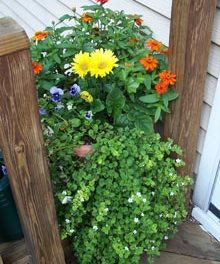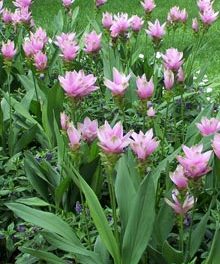 Warm weather was elusive this spring but I think we can once again begin to nurture our gardens. The Master Gardeners at the Farmers Markets are already fielding questions about tomatoes.
Warm weather was elusive this spring but I think we can once again begin to nurture our gardens. The Master Gardeners at the Farmers Markets are already fielding questions about tomatoes.
Everyone wants to grow the old fashioned types. You know the ones I mean, those that you would sink your teeth into right in the field and the warm red juice would dribble down your chin. Remember those?
One might think, in an area with thousands of acres of commercial tomato farms, that growing tomatoes in Beaufort would be an easy task for the home gardener. Not so, according to the many who contact the Clemson Extension Service with questions on this subject. Growing that glorious red orb of old is not so easy anymore. Our soils often harbor microscopic insects and various bacterial, viral and fungal diseases, and the older varieties of tomatoes tend to lack the resistance to things like Nematodes and wilts.
Following good gardening practices, including crop rotation, should help, but that can be difficult. Finding a spot with enough hours of sun, where you have not grown tomatoes for several years – a minimum of 4 is recommended – is difficult in today’s smaller back yards.
Recently, while I was listening to the gardening segment on Clemson’s “Your Day” radio program, Dr. Bob Polomski from Clemson’s Horticulture Dept. had as his guests Georgia’s Walter Reeves of “Your Southern Garden” TV fame and Roger Swain, former host on the original “Victory Garden” TV show. I cannot begin to guess what combined years of experience between these three horticulturists, but I suspect it would be a significant number. These are highly esteemed gentlemen in their field.
They were having a good time enjoying each other’s company and answering gardening questions when someone called in asking about how to grow tomatoes in soil that had nematodes. They went over the usual recommendations and then the caller said, “but what do you think of straw bale gardens; do you think that would work to prevent the soil borne insects and diseases?” There was a moment of silence, then you could hear the three experts mumbling, “Why didn’t we think of that? Of course that should work.” Too bad it was radio; I would have loved to see the expressions on their faces.
Straw bale gardening involves planting your vegetables and flowers in bales that are set on top of your existing soil or sod. They are similar to raised beds, but growing in straw eliminates the possibility of soil borne pathogens. By the end of the season, the bales will be completely decomposed. And because you will always be starting new each year, you can, with a bit of good garden hygiene, use the same sunny spot in your yard. It is a little tricky to get started, and it is essential that you water the bales daily, but otherwise this is not a difficult method.
You will want to find that spot that gets a minimum of six hours of sun and carefully set your bale(s) in place. Once they are wet, they are heavy and impossible to move. Wheat straw bales seem to work best, but you can use hay, oat or barley, too; whatever is available. Set the bales with the strings on the sides – this helps to hold them together longer. If you have the time, you need do nothing more than water the bales every day for about four weeks; at that point, they should have begun to compost. For those of us who are in a hurry, you achieve the same results in about ten days. Start by wetting bales until they are well soaked every day for three days. On days 4 through 6, sprinkle the bales with a nitrogen fertilizer source like ammonium nitrate, blood meal or, if you prefer something more organic, fish emulsion. Use about 1/2 cup per bale, and remember to keep watering the bales. On days 7 through 9, cut back the fertilizer to 1/4 cup. From day 10 on, just water daily. As the bales compost they will heat up; as soon as it cools down enough so you can comfortably stick your hand in the bale it is ready to plant. This is a natural process and the weather can affect the results; your bales may take longer to heat up and cool down to the desired temperature, which would be about the same as your body temperature.
Once everything is ready, use a small trowel to make a slit in the bale, insert your plants and stake them at this time with something sturdy; wire cages will not work well with bales. Some people like to add a handful of mushroom compost or even just a bit of potting soil to the hole, but this is not essential. Mulch is optional also, but generally a good idea as it will help to keep any grassy shoots from the straw or hay from popping up. In our climate, daily watering is essential, so consider setting up a soaker hose on a timer. Depending on the eventual size of the specific tomato variety you have chosen, you can plant between two and three plants per bale. Because they are not growing in soil, your plants will need additional fertilization, and frequent applications of half strength liquid food is advised. At the end of the season, you can spread the straw, which should be completely composted at this point, throughout your garden. It will continue to work for you by enriching the soil.
An Internet search on Straw Bale Gardening produces a number of results, many of which lead to the back yard research done by a gentleman named Kent Rogers from Wake Forest, NC. Kent has been experimenting with the system for many years and generously shares his advice and his photos. http://www.4042.com/4042forums/showthread.php?t=12405
You can grow almost anything in straw bales using these techniques, but the possibility of growing tomatoes without having to deal with nematodes and other soil borne menaces makes it particularly enticing. My bales are already soaking; I’ll let you know later on in the season how it worked out.
Upcoming Gardening Events
• Be sure to check out the Lunch and Learn classes being held every Saturday at the Port Royal Farmer’s Market each Saturday at noon.
• Charleston Horticultural Society’s Plantasia – April 12 & 13th, Wragg Square, Charleston. (843) 579 9922. www.chashortsoc.org
• Sacred Heart Garden Festival, Augusta, GA, April 26 – 28th, (706) 826 4700. www.sacredheartgardenfestival.org
• Open Days Garden Tour, Spoleto Festival – May 25th, Charleston. (843) 579 9922. www.chashortsoc.org







